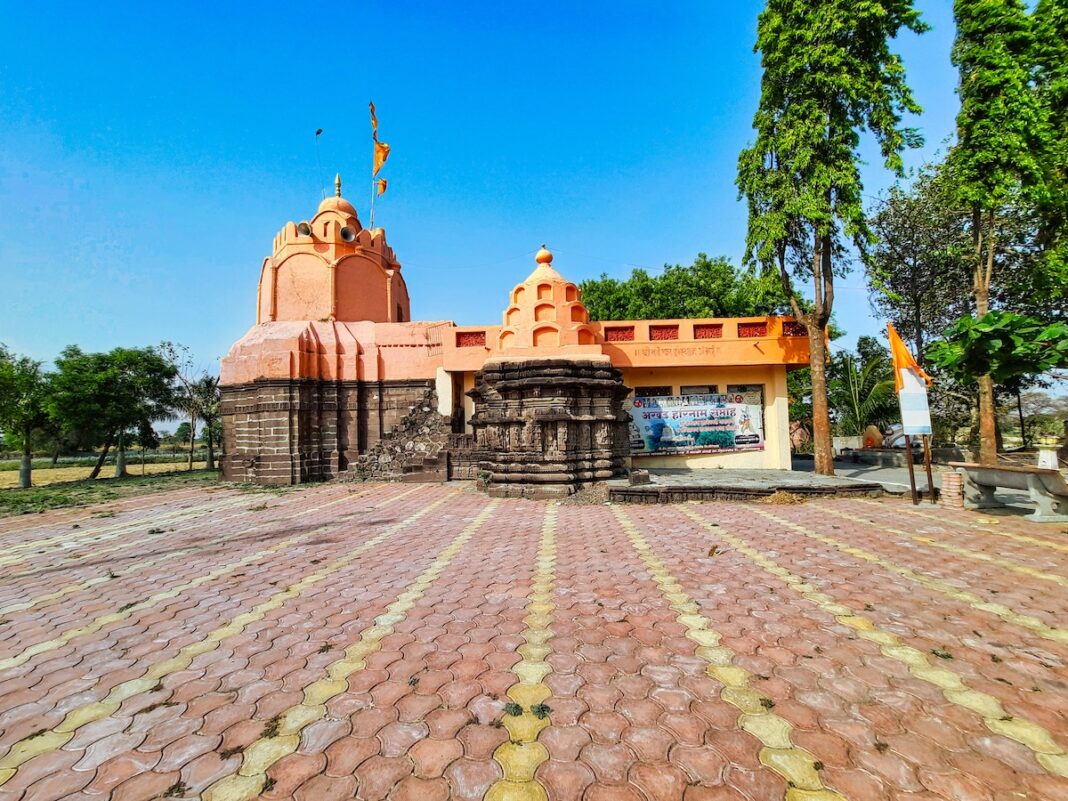Ambhai is a small village in the Aurangabad (renamed to Chhatrapati Sambhajinagar) district of Maharashtra. This otherwise nondescript village is famous for its Wadeshwara temple.
Wadeshwara Temple – The temple faces east and consists of three garbha-grhasi (sanctum sanctorum), each in the south, west, and north. All the garbhagrhas are connected with a single common mandapa (hall) through individual antarala (vestibule). The garbhagrha in the west is dedicated to Shiva, the south is dedicated to Vishnu, and the north is dedicated to sapta-matrikas or some goddess. The adhishthana (base) has multiple moldings, a upana, antrapatta, kumuda, antarapatta, and another kumuda with saw-like toothed projections. The jangha is divided into two tiers, the lower tier has niches carrying images and the upper tier has multiple moldings devoid of sculpture. The jangha is surmounted by projecting eaves carrying chaitya motifs on the top. Jangha of the subsidiary shrines in the north and the south has survived in good detail, however, the exterior of the mains shrine is a reconstruction with plain blocks.
The sculptural program over the jangha follows the usual pattern. The niches over the karnaratha are occupied by dikpalas of the facing direction. The niches over the pratiratha are occupied by celestial damsels, apsaras, or surasundari. The main niche over the bhadraratha has an image of the deity belonging to the family of the dedicatory deity of that shrine. The shrine dedicated to a goddess with Sapta-matrika over its lintel has images of Chamunda, Kartikeya (?), and Shiva-Natesha in its bhadra niches. The shrine dedicated to Vishnu has images of Varaha, Narasimha, and Surya in its bhadra niches.
The central shrine facing west has tri-shakha (three bands) doorway, the first shakha has a floral scroll design, the middle shakha has figures of musicians, and the third shakha has animal figures. The doorway is flanked by pilasters with the bases left uncarved similar to the three shakhas. The doorway appears incomplete as the usual figures of dvarapalas and attendants are missing over the bases. However, as the doorways of the other two subsidiary shrines are complete with all the required figures, etc., it is indeed curious why the doorway of the main central shrine was left incomplete. The lalata-bimba carries an image of Ganesha and an architrave above the lintel has a frieze of five niches made of pillared shrines. Inside the garbhagrha is a linga. The antarala has niches on its lateral wall, which are empty at present.
The shrine in the south is more decorated than the central shrine. The doorway is trishakha like the central shrine. Ganesha is present over the lalata-bimba. The upper lintel has Vishnu in the center with Shiva and Brahma over the terminals. The recessed space is occupied by standing figures of Navagrhas. The presence of Vishnu in the center suggests the shrine was dedicated to him. The antarala has niches, on its lateral walls, occupied by Brahmi and Vaishnavi.
The northern shrine, like its counterpart in the north, is similarly decorated more than the central shrine. The doorway is trishakha resembling the central shrine. Ganesha is present over the lalata-bimba. The upper lintel has seven figures of the Saptamatrika group. The presence of Saptamatrikas in the upper lintel suggests that the shrine was dedicated to some goddess. The antarala has niches, on its lateral walls, occupied by Brahmi and Vaishnavi. Deglurkar assigns the temple to the Kalyani Chalukya period of the first half of the 12th century CE.1
1 Deglurkar, G B (1971). Cultural History of Marathwada (With Special Reference to the Old Monuments From A.D. 6th to 13th cent.), a Ph. D. thesis submitted to the University of Poona. p. 219
Acknowledgment: Some of the photos above are in CC0 1.0 Universal Public Domain from the collection released by the Tapesh Yadav Foundation for Indian Heritage.

